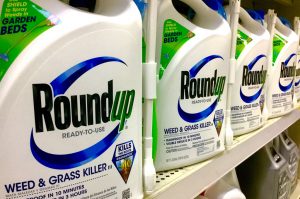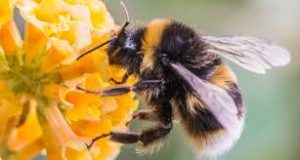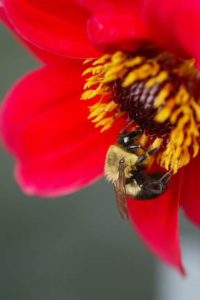30
Mar
Chemical-Intensive Farms Singled Out for Excessive Use of “New” Nitrogen Fertilizers
 (Beyond Pesticides, March 30, 2018) While conventional farming practices rely primarily on new sources of synthetic nitrogen fertilizer to grow crops, organic agriculture conserves nitrogen by using recycled sources, as detailed by new research published by the University of Virginia (UVA) and The Organic Center. Of concern is ‚Äėreactive nitrogen,‚Äô which is nitrogen in a form that will eventually be used by plants (ex. nitrous oxide (N2O), nitrate (NO3–), nitrite (NO2–), ammonia (NH3), and ammonium (NH4+)), rather than benign, non-reactive nitrogen in the form of N2.¬† ‚ÄúThis research is significant and timely because its findings show that many common organic farming practices‚ÄĒlike composting and the use of manure fertilization in place of synthetic fertilizers‚ÄĒcan recycle reactive nitrogen that is already in the global system rather than introducing new reactive nitrogen into the environment, and thus have a much smaller environmental impact,‚ÄĚ said Jessica Shade, PhD of The Organic Center.
(Beyond Pesticides, March 30, 2018) While conventional farming practices rely primarily on new sources of synthetic nitrogen fertilizer to grow crops, organic agriculture conserves nitrogen by using recycled sources, as detailed by new research published by the University of Virginia (UVA) and The Organic Center. Of concern is ‚Äėreactive nitrogen,‚Äô which is nitrogen in a form that will eventually be used by plants (ex. nitrous oxide (N2O), nitrate (NO3–), nitrite (NO2–), ammonia (NH3), and ammonium (NH4+)), rather than benign, non-reactive nitrogen in the form of N2.¬† ‚ÄúThis research is significant and timely because its findings show that many common organic farming practices‚ÄĒlike composting and the use of manure fertilization in place of synthetic fertilizers‚ÄĒcan recycle reactive nitrogen that is already in the global system rather than introducing new reactive nitrogen into the environment, and thus have a much smaller environmental impact,‚ÄĚ said Jessica Shade, PhD of The Organic Center.
Earlier this year, researchers at the University of California Davis published¬†a¬†study in Science Advances¬†with the finding that regulators in the state drastically underestimate chemical-intensive agriculture’s contribution to nitrogen oxide (NOx) caused air pollution, acid rain, and respiratory illness in the state. While NOx ¬†pollution is usually associated with energy production and vehicle emissions, fertilizer use on crop fields is contributing to significant air pollution problems. Advocates have said that the study is an urgent call for farmers to eliminate dependency on soluble, synthetic, nitrogen-based fertilizers and adopt the use of insoluble soil amendments that support soil biology that provide plants with nutrients.
Nitrogen fertilizer is associated with a range of human health and environmental problems. Much of the fertilizer that is not taken up by plants is either released into the atmosphere in its reactive form, where it can cause air pollution, or makes its way into waterways, where it can result in toxic algae blooms. In 2016, Florida‚Äôs lake Okeechobee, the largest in the state, experienced an algae bloom that resulted in the Governor declaring an environmental state of emergency. In 2014, a bloom of toxic cyanobacteria, a blue-green algae, contaminated lake Erie so significantly that it resulted in a ‚Äúdo not drink, do not boil‚ÄĚ water crisis in the City of Toledo, Ohio. According to a report published in February 2018, regulators are likely drastically underestimating the amount that nitrogen gasses released from fertilized fields contribute to air pollution.
The health risks of nitrogen pollution are greater than ‚Äúblue-baby syndrome.‚ÄĚ A 2016 found that nitrate that made its way into drinking water was associated with birth defects, cancers, and thyroid problems.
The Organic Center, UVA study found that 60 to 100 percent of inputs on conventional farms came from new sources of reactive nitrogen fertilizer. This is synthetic fertilizer, created by an industrial process known as Haber-Bosch, wherein benign nitrogen from the air is converted into ammonia. This form of nitrogen is immediately available to plants.
On the other hand, organic farms were found to utilize nitrogen primarily from recycled sources, such as compost and manure. This accounts for between 80 and 95 percent of nitrogen used in organic agriculture, with the only new nitrogen formed being that which is produced by nitrogen-fixing bacteria on the roots of legumes and cover crops. Overall, researchers found that organic practices resulted in 64% less new nitrogen into the environment.
The Organic Center‚Äôs Tracy Misiewicz, PhD notes, ‚ÄúThe total number of nitrogen atoms on Earth remains constant, so we need to understand what proportion of the total is present in a polluting form vs. a non-polluting form. This research shows that rather than converting benign nitrogen into polluting nitrogen, organic farming practices overwhelmingly recycle reactive nitrogen instead of introducing new reactive nitrogen into our environment.‚ÄĚ
Moreover, the recycled sources of nitrogen used on organic farms usually require microbial action in order to convert nitrogen into a plant available form. This ensures that nitrogen added to these fields stays in place longer, rather than running off into local waterways or emitting polluted forms into the atmosphere.
These data mean that 93% of conventional food consumed comes from newly created nitrogen sources, while only 33% of organic nitrogen came from new sources.
Organic systems never employ the use of synthetic nitrogen fertilizers produced via the Haber-Bosch process. Synthetic fertilizers are prohibited under the Organic Foods Production Act, the statute that establishes organic certification and the USDA organic food label. Concerned consumers can help support an environmentally stable, less polluted food production system by purchasing organic food whenever possible. Individuals can also get involved by passing policies that stop the use of synthetic inputs in their community, and eliminate the use of synthetic fertilizers on their own property by referring to Beyond Pesticides’ List of Organic Compatible Fertilizer Products.¬† Follow the lead of communities like Dover, NH, which recently restricted both synthetic pesticide and fertilizer inputs. Contact Beyond Pesticides at [email protected] or 202-543-5450, for resources to create change.
All unattributed positions and opinions in this piece are those of Beyond Pesticides.
Source: The Organic Center









 (Beyond Pesticides, March 29, 2018) Rising use of antibacterials like
(Beyond Pesticides, March 29, 2018) Rising use of antibacterials like  (Beyond Pesticides, March 28, 2018) 
(Beyond Pesticides, March 28, 2018)  (Beyond Pesticides, March 27, 2018) In a major win for farmworker and health groups, the U.S. District Court for the Northern District of California 
(Beyond Pesticides, March 27, 2018) In a major win for farmworker and health groups, the U.S. District Court for the Northern District of California  (Beyond Pesticides, March 26, 2018) 
(Beyond Pesticides, March 26, 2018)¬† (Beyond Pesticides, March 23, 2018) French scientists and ornithologists say parts of the country‚Äôs forests, streams, and bucolic landscapes could be completely devoid of birdsong this year, as the results of two recent studies show staggering declines in bird populations throughout the nation linked to the intensification of agricultural practices and pesticide use. The advent of so many significant wildlife declines at the same time ‚Äďnow recognized in birds, but also seen in
(Beyond Pesticides, March 23, 2018) French scientists and ornithologists say parts of the country‚Äôs forests, streams, and bucolic landscapes could be completely devoid of birdsong this year, as the results of two recent studies show staggering declines in bird populations throughout the nation linked to the intensification of agricultural practices and pesticide use. The advent of so many significant wildlife declines at the same time ‚Äďnow recognized in birds, but also seen in  (Beyond Pesticides, March 22, 2018) Last week Environmental Protection Agency (EPA) Administrator Scott Pruitt received a letter from twenty-eight U.S. Senators urging the preservation of rules that would protect farmworkers and disallow minors to handle highly toxic pesticides. At issue are two proposals from Administrator Scott Pruitt‚Äôs EPA that would roll back Agricultural Worker Protection Standards (AWPS) and the Certification of Pesticide Applicators (CPA) rules put in place during the Obama Administration. In their letter, the Senators stress the impact of any potential changes, noting ‚Äúthe lives of children and families across the country at stake.‚ÄĚ
(Beyond Pesticides, March 22, 2018) Last week Environmental Protection Agency (EPA) Administrator Scott Pruitt received a letter from twenty-eight U.S. Senators urging the preservation of rules that would protect farmworkers and disallow minors to handle highly toxic pesticides. At issue are two proposals from Administrator Scott Pruitt‚Äôs EPA that would roll back Agricultural Worker Protection Standards (AWPS) and the Certification of Pesticide Applicators (CPA) rules put in place during the Obama Administration. In their letter, the Senators stress the impact of any potential changes, noting ‚Äúthe lives of children and families across the country at stake.‚ÄĚ high levels of glyphosate in their bodies are more likely to have shorter pregnancies. Shorter pregnancies can lead to children with reduced learning and brain development. This is the first study to suggest that exposures to glyphosate can influence the long-term well-being of children.
high levels of glyphosate in their bodies are more likely to have shorter pregnancies. Shorter pregnancies can lead to children with reduced learning and brain development. This is the first study to suggest that exposures to glyphosate can influence the long-term well-being of children. (Beyond Pesticides, March 20, 2018) Regulations that separate ingredients in
(Beyond Pesticides, March 20, 2018) Regulations that separate ingredients in  (Beyond Pesticides, March 19, 20018) 
(Beyond Pesticides, March 19, 20018)  (Beyond Pesticides, March 16, 2018) In a pattern of U.S. Department of Agriculture (USDA) actions that hurt the integrity of the organic label on food products, the agency has decided to withdraw final organic
(Beyond Pesticides, March 16, 2018) In a pattern of U.S. Department of Agriculture (USDA) actions that hurt the integrity of the organic label on food products, the agency has decided to withdraw final organic  (Beyond Pesticides, March 15, 2018) On Tuesday, a group of 56 scientists studying the effects of neonicotinoids sent a letter to California’s Department of Pesticide Regulation (CDPR) highlighting the threat neonicotinoids pose to the health of California’s waterways. The scientists urge CDPR to take steps to reduce neonicotinoid contamination of the state’s streams and rivers. This comes as neonicotinoids were recently reported to be pervasive throughout the Great Lakes, and federal assessments confirm high risks to aquatic species.
(Beyond Pesticides, March 15, 2018) On Tuesday, a group of 56 scientists studying the effects of neonicotinoids¬†sent a letter to California‚Äôs Department of Pesticide Regulation¬†(CDPR) highlighting the threat neonicotinoids pose to the health of California‚Äôs waterways. The scientists urge CDPR to take steps to reduce neonicotinoid contamination of the state‚Äôs streams and rivers. This comes as neonicotinoids were recently reported to be pervasive throughout the Great Lakes, and federal assessments confirm high risks to aquatic species. from last year‚Äôs numbers‚ÄĒa 15 percent decrease ‚Äďaccording to figures from an official Mexican government count in the winter of 2017. These numbers underscore how at risk the iconic animal is, with a possible collapse of migration if populations are critically low.
from last year‚Äôs numbers‚ÄĒa 15 percent decrease ‚Äďaccording to figures from an official Mexican government count in the winter of 2017. These numbers underscore how at risk the iconic animal is, with a possible collapse of migration if populations are critically low.
 European Regulators Confirm Neonicotinoids Harm Bees, Increasing Likelihood of Continent-Wide Ban
European Regulators Confirm Neonicotinoids Harm Bees, Increasing Likelihood of Continent-Wide Ban fatty acids than conventional and even organic milk, according to a study published by an international team of scientists in the journal
fatty acids than conventional and even organic milk, according to a study published by an international team of scientists in the journal  predators, like bats and falcons on farms, can reduce pesticide use, increase on-farm productivity, and conserve wildlife, according to a literature review published by researchers at Michigan State University in the journal
predators, like bats and falcons on farms, can reduce pesticide use, increase on-farm productivity, and conserve wildlife, according to a literature review published by researchers at Michigan State University in the journal  the world, do pose risks to honey bees and wild pollinators, according to a
the world, do pose risks to honey bees and wild pollinators, according to a  restrict the use of toxic pesticides, and move towards organic land management on all public property. By a unanimous vote of the City Council last week, Dover passed a resolution that requires the management of city land with ‚Äúsound land management practices, and the use of least toxic compounds only when necessary,¬† . . .¬† thereby eliminating exposure to toxic pesticides on the part of our citizens and the environment.‚ÄĚ The ordinance also instructs the city manager to ‚Äúdevelop and execute a plan to transition the City to eliminate the use of synthetic fertilizers on City property.‚ÄĚ
restrict the use of toxic pesticides, and move towards organic land management on all public property. By a unanimous vote of the City Council last week, Dover passed a resolution that requires the management of city land with ‚Äúsound land management practices, and the use of least toxic compounds only when necessary,¬† . . .¬† thereby eliminating exposure to toxic pesticides on the part of our citizens and the environment.‚ÄĚ The ordinance also instructs the city manager to ‚Äúdevelop and execute a plan to transition the City to eliminate the use of synthetic fertilizers on City property.‚ÄĚ food that is grown there. Unless all that food is organic,
food that is grown there. Unless all that food is organic,  decrease air pollution from cars and other vehicles, scientists are finding that the use of pesticides and other household chemicals represent an increasing proportion of smog-forming pollution in the U.S. Research published in the journal
decrease air pollution from cars and other vehicles, scientists are finding that the use of pesticides and other household chemicals represent an increasing proportion of smog-forming pollution in the U.S. Research published in the journal 
